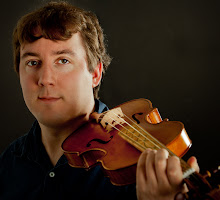Treatises in general have been regarded by Early Musicians as the musical bibles of times past. We open them up in order to receive The Word. This makes us feel like we're being historical and authentic. The Word is applied as literally as possible and if we hear someone 'modern' at a concert doing something totally different, we either grimace in disbelief or chuckle with satisfaction, reflecting on how the performer has not been granted The Word.
This pervasive view of treatises, admittedly more dogmatic in the early days of the HIP movement, has affected the psychology of many mainstream players. Those who never could stand the idea of performance practice to begin with simply rejected the treatises straightaway. Modern players felt that what they were doing was totally authentic because it was true to them. They didn't need rules and regulations from some dead guy who played on inferior instruments anyway, and they would just keep doing what they were doing, thank you very much. However, those who were interested in performance practice and how they could apply it to their modern instruments when playing early music were infected by the concept of The Word.
 Several specific elements of performance practice gleaned from treatises went viral, Rebecca-Black-style, in the early days of the movement. For string players, the ultimate rule dictated that vibrato was not allowed. Modern violinists and cellists, in an effort to be authentic, shut down the engine in their left hand when playing Bach, Vivaldi, Haydn, Mozart or whatever. Pianists did the equivalent for their instrument; their right foot and the sustaining pedal were now forced to repel each other like identical magnetic poles.
Several specific elements of performance practice gleaned from treatises went viral, Rebecca-Black-style, in the early days of the movement. For string players, the ultimate rule dictated that vibrato was not allowed. Modern violinists and cellists, in an effort to be authentic, shut down the engine in their left hand when playing Bach, Vivaldi, Haydn, Mozart or whatever. Pianists did the equivalent for their instrument; their right foot and the sustaining pedal were now forced to repel each other like identical magnetic poles.Secondly, the rule of the downbow and the dominance of the downbeat became fundamental, at the expense of natural phrasing. Musicians started just nudging the first beat of every bar, and that became an acknowledged part of the 'baroque' style.
 Finally, the correct execution of ornaments became paramount. Trills had to always start from above the main note, a grace note took on exactly half the value of the note that it preceded, and tables of ornaments were studied diligently to make sure that no obscure musical twiddle was mistakenly interpreted. The concern over ornaments is still at the forefront of modern pianists' minds today. In a class I took last year on early keyboard literature, Indiana University's wonderful harpsichord professor, Elisabeth Wright, came in to give a presentation about the instrument. When she asked for questions at the end, the first question from the pianists was "How do I do ornaments?" For pianists, the correct way of ornamenting is a primary way for them to feel authentic when playing Couperin, Rameau, Bach etc on their Steinway.
Finally, the correct execution of ornaments became paramount. Trills had to always start from above the main note, a grace note took on exactly half the value of the note that it preceded, and tables of ornaments were studied diligently to make sure that no obscure musical twiddle was mistakenly interpreted. The concern over ornaments is still at the forefront of modern pianists' minds today. In a class I took last year on early keyboard literature, Indiana University's wonderful harpsichord professor, Elisabeth Wright, came in to give a presentation about the instrument. When she asked for questions at the end, the first question from the pianists was "How do I do ornaments?" For pianists, the correct way of ornamenting is a primary way for them to feel authentic when playing Couperin, Rameau, Bach etc on their Steinway. Many performances of baroque music in the first decades of the HIP era were a product of these elements: non-vibrato, accented downbeats, minimal phrasing in the modern sense, and correct ornaments. Today, musical inspiration and imagination have thankfully returned in the world of early music making, but the aforementioned elements are still basic principles of how to start approaching music of the Baroque and Classical eras.
Treatises are indeed one of the essential windows to how music was thought of and played at the time the music was originally composed. But they can obviously be taken too literally and with a closed mind. Rather than regarding them as The Word, I believe reading a treatise should be seen as giving ourselves the chance to have a music lesson with Quantz, Geminiani, Leopold Mozart, Caccini, or whoever. For example, if we were to get in a time machine and go back to 1752, here is what Quantz would advise us about all aspects of good musicianship. If we were to go back to Italy in 1607, this is what Agostino Agazzari would tell us about good continuo playing. If we were to stop by the house of Georg Muffat in 1695, he would impart to us his knowledge of the highly regarded orchestral practices and character of French music under Lully at the court of Versailles. In the same way that music students take lessons and gain wisdom from many different teachers today, we are thus free to take the information or leave it, according to our tastes. We should not feel restricted by a teacher's advice. We should feel inspired by it.

No comments:
Post a Comment